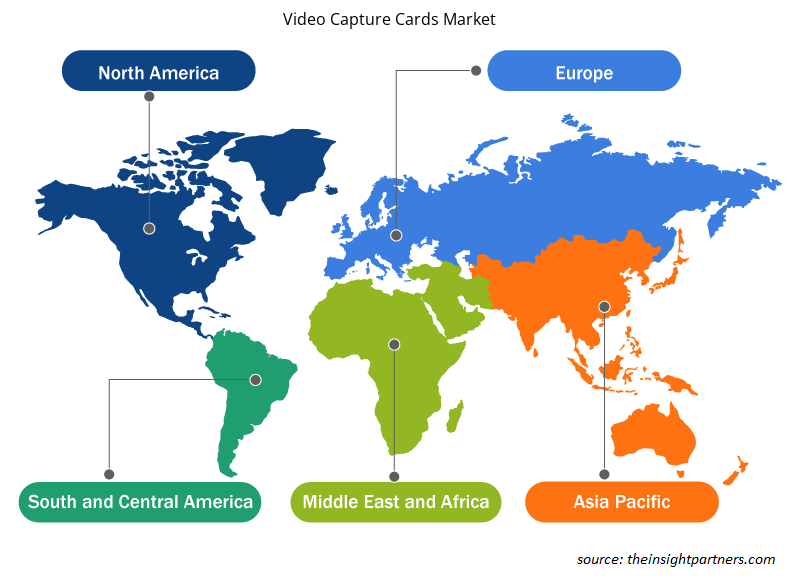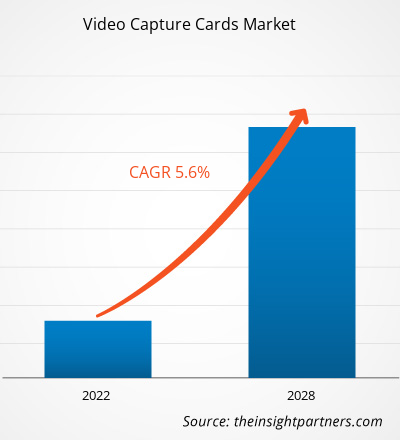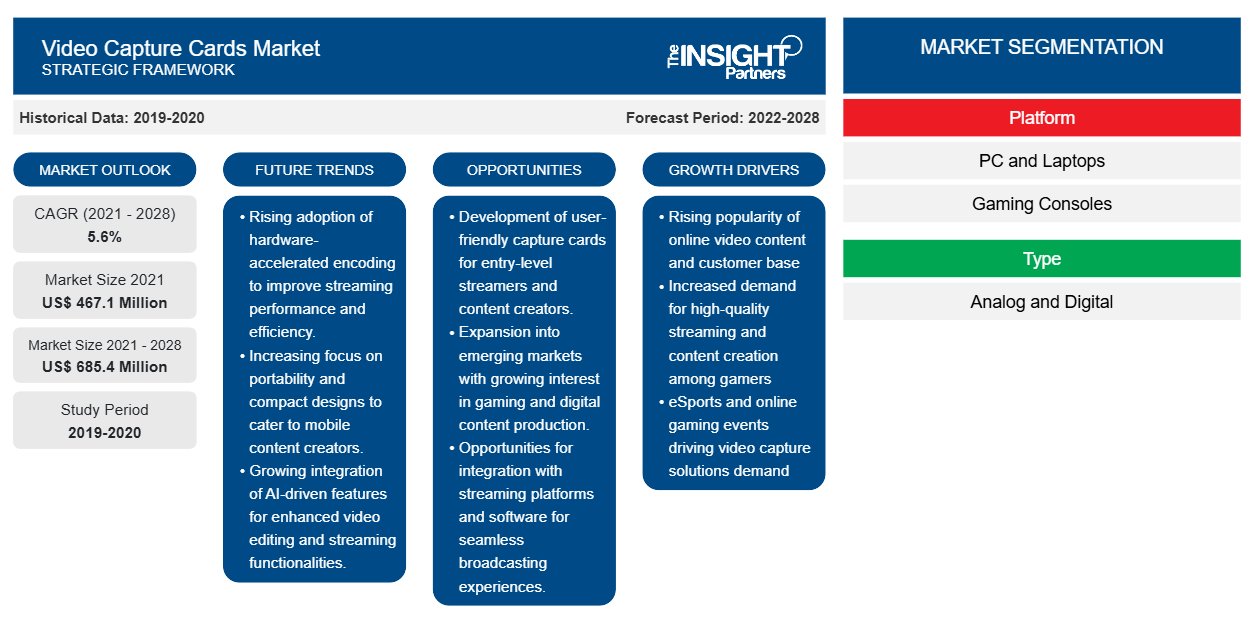Der Markt für Videoaufnahmekarten soll von 467,1 Millionen US-Dollar im Jahr 2021 auf 685,4 Millionen US-Dollar im Jahr 2028 wachsen; von 2021 bis 2028 wird mit einer durchschnittlichen jährlichen Wachstumsrate von 5,6 % gerechnet.
Das Wachstum des Marktes für Videoaufnahmekarten ist auf die steigende Popularität von Online-Videoinhalten auf Social-Media-Plattformen zurückzuführen. Die zunehmende Popularität verschiedener Social-Media-Plattformen und die darauffolgende Verlagerung mehrerer Werbe- und Marktausgaben, die auf diesen Plattformen zusammenlaufen, haben insbesondere in den letzten Jahren eine beispiellose Dynamik erreicht. Darüber hinaus steigert der wachsende Trend von Social-Media-Influencern und professionellen Videobloggern sowie der bemerkenswerte Anstieg der Zahl von Verkäufern von Online-Videoinhalten die Nachfrage nach kreativen Videoinhalten. Die qualitativ verbesserten Videoinhalte haben daher die Verbreitung von Videoaufnahmekarten und Softwareanwendungen erleichtert, was wiederum das Wachstum des Marktes für Videoaufnahmekarten ankurbelt. Darüber hinaus haben mehrere Marktteilnehmer mit dem Erwerb von Videoaufnahmekarten zahlreiche Smartphone-spezifische Software auf den Markt gebracht, die auf diese schnell wachsende Kundenbasis abzielt. Daher wird erwartet, dass die zunehmende Popularität einer auf Online-Videoinhalten basierenden Kundenbasis wie Inhaltsverkäufern, Werbetreibenden und Influencern den Marktteilnehmern für Videoaufnahmekarten in den kommenden Jahren zahlreiche lukrative Wachstumschancen bieten wird. Professionelle Medienproduktionshäuser wie Unterhaltungsindustrie, Gaming, Medien und Bildungseinrichtungen sind jedoch weiterhin weltweit einer der Hauptnutzer von Videoaufnahmekarten. Darüber hinaus sorgt das Aufkommen mehrerer regionaler Kinos und Online-Inhalte für OTT-Plattformen in verschiedenen Bevölkerungsgruppen in asiatischen und afrikanischen Ländern für eine Nachfrage nach Videoaufnahmekarten, was wiederum die Videoaufnahmekarten in Schwellenländern vorantreiben wird.
Passen Sie diesen Bericht Ihren Anforderungen an
Sie erhalten kostenlos individuelle Anpassungen an jedem Bericht, einschließlich Teilen dieses Berichts oder einer Analyse auf Länderebene, eines Excel-Datenpakets sowie tolle Angebote und Rabatte für Start-ups und Universitäten.
-
Holen Sie sich die wichtigsten Markttrends aus diesem Bericht.Dieses KOSTENLOSE Beispiel umfasst eine Datenanalyse von Markttrends bis hin zu Schätzungen und Prognosen.
Auswirkungen der COVID-19-Pandemie auf den Markt für Videoaufnahmekarten
Die Auswirkungen von COVID-19 waren in den einzelnen europäischen Ländern unterschiedlich, da in ausgewählten Ländern die Zahl der registrierten Fälle zunahm und in der Folge strenge und längere Lockdowns oder soziale Isolation verhängt wurden. Westeuropäische Länder wie Deutschland, Frankreich, Russland und Großbritannien verzeichneten jedoch aufgrund ihres starken Gesundheitssystems einen vergleichsweise geringen Rückgang ihrer Wachstumsaktivitäten. Um ihre Bürger vor dem Virus zu schützen, haben die europäischen Regierungen enorme Investitionen in die Integration von Technologien in ihre Gesundheitssysteme getätigt, um Anzeichen des Virus zu erkennen.
Aufgrund des plötzlichen Ausbruchs des COVID-19-Virus und der Lockdowns in fast allen großen Ländern Europas verzeichnete die Region einen Anstieg der Fernsehnutzung, der Erstellung von Videos für soziale Medien und der Akzeptanz von Videospielen in der Bevölkerung. Während der Pandemie verzeichnete das Internet-Gaming Rekordzahlen an Spielern als gängige Aktivität, um die physische Distanz der Gesellschaft zu überwinden, da die regionale Bevölkerung zu Hause war und nicht arbeiten konnte – eine von der Weltgesundheitsorganisation befürwortete Strategie, die vielen Gaming-Unternehmen geholfen hat, ihre Gewinne zu steigern. Seit dem 23. März 2020 gibt es aufgrund der COVID-19-Pandemie und der daraus resultierenden sozialen Distanzierung einen Anstieg der Zahl der Menschen, die Videospiele spielen. Der Anstieg war in Frankreich (41 %) am stärksten, gefolgt von Großbritannien (28 %) und Deutschland (23 %). Dies hat die Nachfrage nach Videoaufnahmekarten auf dem gesamten Markt geschaffen. Aufgrund der vorübergehenden Schließung von Produktions- und Lieferkettenaktivitäten durch die lokalen Regierungen wurde der Vertrieb des Spielzubehörs jedoch stark beeinträchtigt, was sich negativ auf den gesamten Markt für Videoaufnahmekarten in der Region auswirkte.
Markteinblicke – Markt für Videoaufnahmekarten
Verwendung von Mobiltelefonen als Konsole
Die zunehmende Nutzung von Smartphones zum Aufzeichnen von Videos und zum Aufzeichnen von Spielen macht sie zu einer Konkurrenz für Spielekonsolen. Dies kann entweder durch das Übertragen von Handyspielen auf das Fernsehen oder das Streamen von Konsolenspielen auf Smartphones erreicht werden. Auch die Verwendung der Kamera eines Smartphones zum Aufzeichnen von Videos in Instagram Reels, Live-Streaming und TikTok-Videos fördert die Nutzung von Videoaufnahmekarten, um dem Benutzer die effiziente Übertragung von Daten auf PCs und Laptops zu erleichtern. Darüber hinaus wird Gaming zu einem Hauptschwerpunkt für Festnetztelefone, was die Aufmerksamkeit von Spielern auf sich zieht. Die Videoaufnahmekarten können problemlos mit verschiedenen Spielekonsolen wie XBOX One, PS3 und PS4 verbunden werden. Sie helfen dabei, atemberaubende Grafiken und eine beeindruckende Auflösung des Gameplays aufzuzeichnen. Die Marktteilnehmer konzentrieren sich auf die Entwicklung neuer Snapdragon-Prozessoren der Spitzenklasse, die das Potenzial haben, ausreichende Leistung in Audio, Video und Grafik für Konsolen mit hochwertigen Spielen zu bieten. Dennoch werden High-End-Spiele wahrscheinlich auf Konsolen laufen, während die meisten Spiele für Mobiltelefone verfügbar sind. Daher haben die Hersteller von Videoaufnahmekarten für Spiele die Möglichkeit, fortschrittliche Videoaufnahmekarten zu entwickeln, die mit Smartphones zum Aufzeichnen von Videos und Spielen kompatibel sind.
Plattformbasierte Einblicke
Basierend auf der Plattform wird der Markt für Videoaufnahmekarten in Spielekonsolen, PCs und Laptops usw. unterteilt. Das Segment der Spielekonsolen hatte im Jahr 2020 den größten Marktanteil.
Typbasierte Erkenntnisse
Der Markt für Videoaufnahmekarten ist nach Typ in digital und analog unterteilt. Das digitale Segment wird im Prognosezeitraum voraussichtlich eine höhere durchschnittliche jährliche Wachstumsrate verzeichnen.
Input-Interface-basierte Erkenntnisse
Basierend auf der Eingangsschnittstelle ist der Markt für Videoaufnahmekarten in HDMI, DP, SDI und andere segmentiert. Das Segment „Andere“ wird im Prognosezeitraum voraussichtlich die höchste durchschnittliche jährliche Wachstumsrate verzeichnen.
Die Akteure auf dem Markt für Videoaufnahmekarten konzentrieren sich hauptsächlich auf die Entwicklung fortschrittlicher und effizienter Produkte.
- Im Jahr 2020 haben VinBus und Advantech Vietnam zusammengearbeitet, um geschäftliche Kooperationsaktivitäten zu fördern und sich gegenseitig in Bezug auf Technologieplattformen und technische Einrichtungen zu unterstützen.
- Im Jahr 2020 halten Advantech und Interlatin 60 % bzw. 40 % der Anteile an der neuen Tochtergesellschaft. Das Joint Venture tritt am 1. Juli 2020 in Kraft und neue Niederlassungen werden in Guadalajara und Mexiko-Stadt eingerichtet.
- Im Jahr 2021 entwickelte Datapath Aetria, das alle Aspekte der Gestaltung, Verwaltung, Steuerung und Überwachung von Kontrollräumen in einer einzigen Lösung vereint. So können Integratoren und Endbenutzer Systeme erstellen, die eine breite Palette von Anforderungen erfüllen, darunter Konnektivität, Videowände, Arbeitsstationen und Quellenverwaltung für kleine bis sehr große Installationen.
Regionale Einblicke in den Markt für Videoaufnahmekarten
Die regionalen Trends und Faktoren, die den Markt für Videoaufnahmekarten im Prognosezeitraum beeinflussen, wurden von den Analysten von Insight Partners ausführlich erläutert. In diesem Abschnitt werden auch die Marktsegmente und die Geografie von Videoaufnahmekarten in Nordamerika, Europa, im asiatisch-pazifischen Raum, im Nahen Osten und Afrika sowie in Süd- und Mittelamerika erörtert.

- Erhalten Sie regionale Daten zum Markt für Videoaufnahmekarten
Umfang des Marktberichts zu Videoaufnahmekarten
| Berichtsattribut | Details |
|---|---|
| Marktgröße im Jahr 2021 | 467,1 Millionen US-Dollar |
| Marktgröße bis 2028 | 685,4 Millionen US-Dollar |
| Globale CAGR (2021 - 2028) | 5,6 % |
| Historische Daten | 2019-2020 |
| Prognosezeitraum | 2022–2028 |
| Abgedeckte Segmente |
Nach Plattform
|
| Abgedeckte Regionen und Länder |
Nordamerika
|
| Marktführer und wichtige Unternehmensprofile |
|
Dichte der Marktteilnehmer für Videoaufnahmekarten: Auswirkungen auf die Geschäftsdynamik verstehen
Der Markt für Videoaufnahmekarten wächst rasant, angetrieben durch die steigende Nachfrage der Endnutzer aufgrund von Faktoren wie sich entwickelnden Verbraucherpräferenzen, technologischen Fortschritten und einem größeren Bewusstsein für die Vorteile des Produkts. Mit steigender Nachfrage erweitern Unternehmen ihr Angebot, entwickeln Innovationen, um die Bedürfnisse der Verbraucher zu erfüllen, und nutzen neue Trends, was das Marktwachstum weiter ankurbelt.
Die Marktteilnehmerdichte bezieht sich auf die Verteilung der Firmen oder Unternehmen, die in einem bestimmten Markt oder einer bestimmten Branche tätig sind. Sie gibt an, wie viele Wettbewerber (Marktteilnehmer) in einem bestimmten Marktraum im Verhältnis zu seiner Größe oder seinem gesamten Marktwert präsent sind.
Die wichtigsten auf dem Markt für Videoaufnahmekarten tätigen Unternehmen sind:
- ADLINK Technology Inc
- Advantech Co. Ltd
- Datapath Limited
- : EURESYS SA
- IMPERX, Inc
Haftungsausschluss : Die oben aufgeführten Unternehmen sind nicht in einer bestimmten Reihenfolge aufgeführt.

- Überblick über die wichtigsten Akteure auf dem Markt für Videoaufnahmekarten
Der Markt für Videoaufnahmekarten ist wie folgt segmentiert:
Markt für Videoaufnahmekarten – nach Plattform
- Spielkonsolen
- PC und Laptops
- Sonstiges
Markt für Videoaufnahmekarten – nach Typ
- Digitales
- Analog
Markt für Videoaufnahmekarten – nach Eingangsschnittstelle
- HDMI
- DP
- SDI
- Sonstiges
Markt für Videoaufnahmekarten – nach Geografie
-
Nordamerika
- UNS
- Kanada
- Mexiko
-
Europa
- Deutschland
- Frankreich
- Italien
- Vereinigtes Königreich
- Russland
- Restliches Europa
-
Asien-Pazifik (APAC)
- Australien
- China
- Indien
- Japan
- Südkorea
- Restlicher Asien-Pazifik-Raum
-
Naher Osten und Afrika (MEA)
- Saudi-Arabien
- Vereinigte Arabische Emirate
- Südafrika
- Rest von MEA
-
Südamerika (SAM)
- Brasilien
- Argentinien
- Rest von SAM
Markt für Videoaufnahmekarten – Firmenprofile
- Airbus SAS
- Leonardo SpA
- Bell Textron Inc.
- Russische Videoaufnahmekarte
- Lockheed Martin Corporation
- Boeing
- Enstrom Helicopter Corp.
- Kaman Corporation
- MD Videoaufnahmekarte, Inc.
- Robinson Helikopter
- Historische Analyse (2 Jahre), Basisjahr, Prognose (7 Jahre) mit CAGR
- PEST- und SWOT-Analyse
- Marktgröße Wert/Volumen – Global, Regional, Land
- Branchen- und Wettbewerbslandschaft
- Excel-Datensatz
Aktuelle Berichte
Erfahrungsberichte
Grund zum Kauf
- Fundierte Entscheidungsfindung
- Marktdynamik verstehen
- Wettbewerbsanalyse
- Kundeneinblicke
- Marktprognosen
- Risikominimierung
- Strategische Planung
- Investitionsbegründung
- Identifizierung neuer Märkte
- Verbesserung von Marketingstrategien
- Steigerung der Betriebseffizienz
- Anpassung an regulatorische Trends























 Kostenlose Probe anfordern für - Markt für Videoaufnahmekarten
Kostenlose Probe anfordern für - Markt für Videoaufnahmekarten